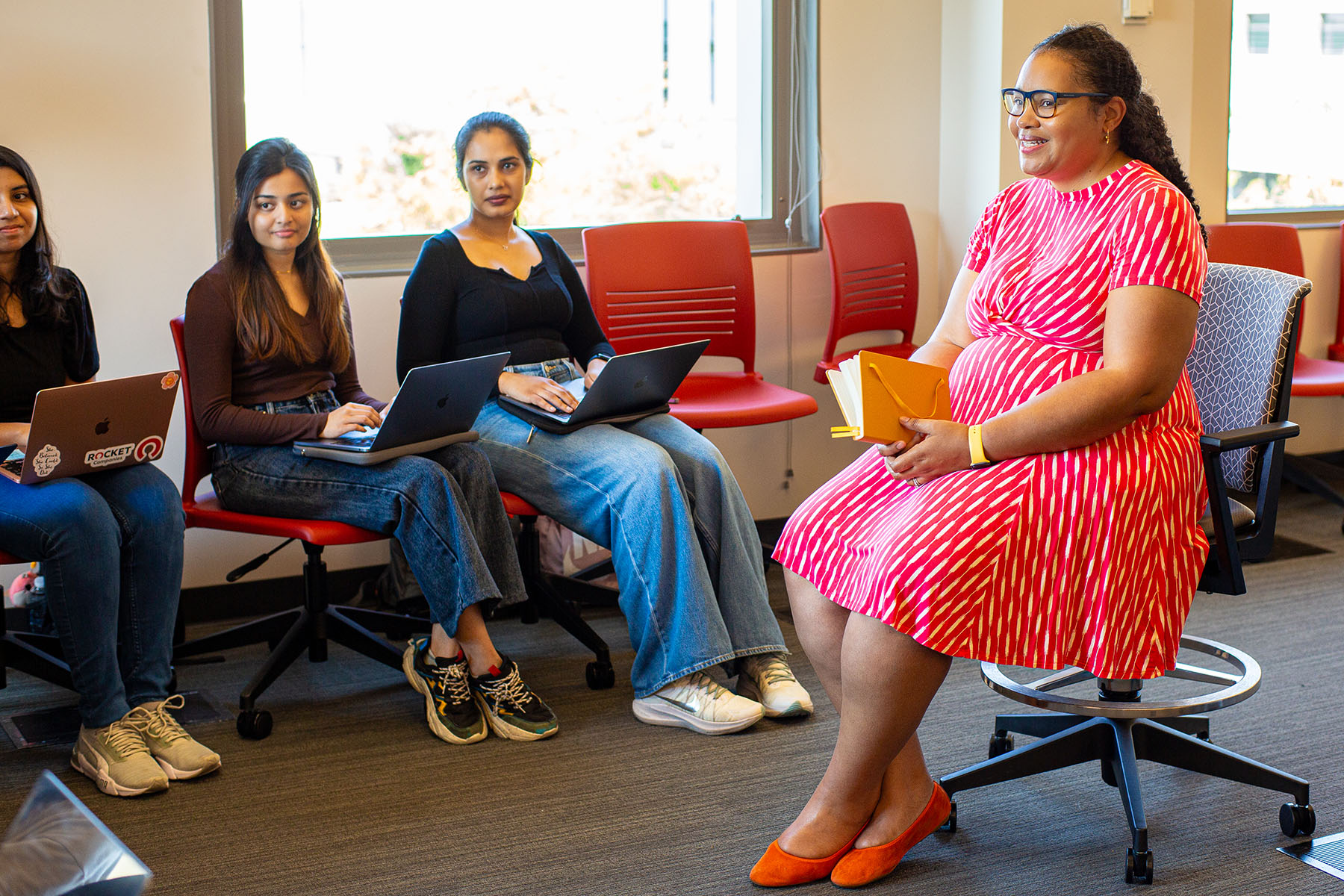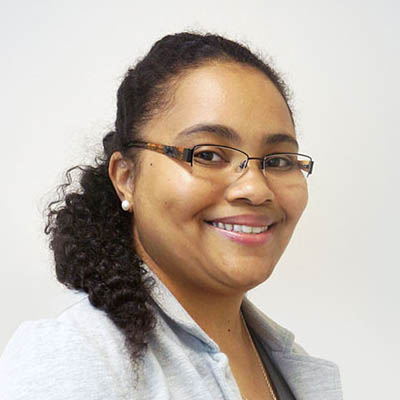Aqueasha Martin-Hammond is researching how technology can help America’s increasingly aging population retain their independence as long as possible.

The storm clouds looming over America’s aging population have been gathering for decades. The post-World War II baby boom created a population bulge that would reach senior citizen status at roughly the same time, straining everything from the Social Security system to the nation’s network of senior housing.
Then came COVID-19.
The weight of a global pandemic fell in full force on America’s caregivers, including those tasked with tending to our increasingly aging population. In 2022, nearly 58 million people in the United States were 65 or older, representing 17.3% of the population. That number is expected to reach 80 million by 2040 and 84 million by 2054, an estimated 23% of all Americans.
And yet, largely because of the crushing weight of COVID that pushed many caregivers beyond their breaking point, every single state reported a shortage of care workers in 2023. Worse, 43 states saw permanent closures of care facilities, such as assisted living centers.
In the middle of this gathering storm stands Aqueasha Martin-Hammond. She is an associate professor of human-computer interactions (HCI) with Indiana University’s Luddy School of Informatics, Computing, and Engineering. Her research aims to break through the storm clouds and create a brighter future for America’s aging population. It centers on figuring out ways to use artificial intelligence (AI) and other technology, including interactive voice assistants, to enable more seniors to stay in their homes longer.
“The technology has to add value to their lives and deliver on what it promised, all with minimum trade-offs,” says Martin-Hammond, who has been with IU for nearly seven years. That means the sometimes muddled interactions Americans of all ages have had with Alexa and Siri need to be much smoother and much more reliable if senior adults are expected to incorporate them into an area of their lives as sensitive and important as their health and well-being.
Dr. Aqueasha Martin-Hammond's research
Description of the video:
So my research spans the areas of human computer interaction aging and Technology um and the projects that I've worked on look at how technology can support older adults with um health and wellness so um when I was in my graduate program um I had um my grandmother had an incident where she was taking medication um that wasn't agreeing with her that sparked my interest in kind of working with older adults as they age for their Health and Wellness and trying to look at how technology might be able to kind of support them as they age we are looking at how we can design intelligent assistants such as Alexa and Siri to support older adults and their informal caregivers their family and friends with health information management task at home um and so we are trying to understand like what they see as potential benefits of those Technologies and design some prototypes around that to test it out but we're also looking at the concerns um and challenges they have for adopting those into their homes and how we can rethink the design to address those so that they um might want to use them in the future um it's important for older adults to continue to maintain social interactions as they age but um sometimes they run into challenges with that so we're looking at conversational assistance as Alexa and Siri and Google home and how those can be redesigned to help them H maintain social connections we our work is more focused on how we can facilitate the human and human how they can be used to facilitate the human to human connections um and also connect older adults with resources so that they can maintain those Human Social connections um as they age one of the collaborative projects that I'm working on is with John Hopkins um and so the project uses um culturally relevant design so we're looking for particularly at um taking stories and Inspirations from the Underground Railroad um and their journey to freedom and using that in the design to motivate people to um adopt and maintain hard healthy behaviors the work that I do wouldn't be possible without the grad students that are involved um we have grad students that work at the Master's and the PHD level so we have them in recruitment they go and they talk to users and do interviews um they do design proc projects and bring those back they're able to kind of talk about their experiences working in the lab when they go out and do their careersStudent-supported research
The promise at the heart of Martin-Hammond’s research has attracted national attention — and dollars. To date, her work has garnered more than $1 million in grants and awards from places as diverse as the National Science Foundation (NSF) and Google. That funding is key to Martin-Hammond’s efforts and to the experiences it creates for Indiana University students.
“Each of the awards has been significant for helping me build an active research lab and supporting students at different levels in doing research,” she says. “My students have been essential in moving the work forward, and I am grateful to be able to provide them with opportunities through these different awards to develop their skills.”
The largest award to date has been the NSF CAREER Award. It provides $543,539 over five years in support of Martin-Hammond’s project called “Conversational User Interfaces to Support Older Adults’ Social Wellness.” The CAREER honor is the NSF’s most prestigious award to support early-career faculty with the potential to serve as academic role models in research and education.
Martin-Hammond is just that — an early-career educator and researcher whose work is inspiring her students to dive deeper into the field of elder care. This project aims to find ways to battle the social isolation seniors often feel, particularly since there are links between loneliness and the cognitive decline that often pushes them out of their homes and into the overtaxed elder-care system.

We hope to uncover barriers to participation and strategies for addressing those barriers so that these tools are more accessible to all
Aqueasha Martin-Hammond
If successful, Martin-Hammond’s research would create new conversational approaches to benefit older adults’ social wellness and decrease the risk and negative health consequences from isolation. It relies on AI-enabled technology such as voice assistants and chatbots to create connections.
“Imagine a future where a tool such as Amazon Alexa could proactively remind us to call a relative on their birthday or go to a neighborhood event where our friends are going by learning about our behaviors and preferences,” she says.
That might be the dream, but it is not the reality Martin-Hammond sees when she looks at today’s technology. The current incarnations of Alexa, Siri, and all other voice assistants might be decent at information retrieval but offer little to help older adults connect with their peers or local resources that promote their continued independence.
Another NSF grant will further Martin-Hammond’s efforts to change that.
This grant of nearly a half-million dollars supports her project entitled, “Designing Autonomy Preserving Interactions in Intelligent Assistants for Older Adults.” It aims to address seniors’ need to streamline organization of doctor’s appointments and medication schedules while fostering greater trust that their sensitive information is protected from those who would use it to prey upon them through scams.
What Martin-Hammond and her students have discovered during the research so far is that there is a wide spectrum of understanding and comfort with digital technology among seniors but a much more narrow set of common concerns with its use. The top three?
- Privacy
- Its contribution to their ability to remain independent
- Cost
Her research is focused on filling a noticeable knowledge void in the academic community on the barriers that exist to use technology to push back against the gathering storm.
Using smart technologies to help Hoosier seniors
Description of the video:
The goal with a lot of the projectsthat I work on is that we can help older adults kind of age
as long as they want to in their homes, and we try to look at ways
we can integrate technology into that process to support older adults. My name is Aqueasha Martin-Hammond. I am an assistant professor
of human-computer interaction here at the School of Informatics
and Computing at IUPUI. I work mostly with folks in Indianapolis
looking at ways that intelligent systems, such as Alexa or Google Home
or those types of voice-based systems, can support older adults to better
manage their health and well-being. We talk to older adults
with different levels of access to, for example, technology and Internet, and seeing how we can rethink
how we approach the design of those technologies
to support them.
It's important to empower older adults in this process
because, as we see more and more technologies
kind of emerging, sometimes they don't seem as useful or sometimes they're not well adopted by older adults. And really looking forward
to kind of brainstorming with my students and with others on ways
that we can kind of grow this area and make it more practical
and have real world change.
A second focus
The looming senior situation isn’t the only storm Martin-Hammond is trying to address. Her research also focuses on using the same type of technology to improve heart health among those traditionally underserved by America’s healthcare system.
In 2021, Martin-Hammon received the inaugural Google Award for Inclusion Research. The $60,000 award supported her project, “Culturally Relevant Collaborative Health Tracking Tools for Motivating Heart-Healthy Behaviors Among African-Americans.” That research is built on the foundation of disturbing data that shows Black Americans are far more likely to die from heart disease than non-Hispanic white Americans.
For example, in 2019, Black Americans were 30% more likely to die from heart conditions than their white counterparts. Black men have a 70% higher risk of heart failure than white men, and Black women have a 50% higher risk than white women.
Martin-Hammond is using the Google research funding to investigate strategies to support collaborative digital health tracking for Black Americans by examining ways to design, translate, and scale an evidence-based community health program. The hope is that the work will even reach beyond the targeted population.
“We hope to uncover barriers to participation and strategies for addressing those barriers so that these tools are more accessible to all,” Martin-Hammond says. “From this work, we hope to learn more about designing collaborative digital tracking tools that motivate heart-healthy behaviors among all groups at high risk of major cardiovascular disease.”
A local connection
Martin-Hammond’s research has national — and even international — implications. America is far from unique with its aging population. Yet this far-reaching work starts with a strong local focus. Martin-Hammond’s projects often lean on the Hoosier State’s senior population to gather information. She has established numerous partnerships with local senior organizations and caregivers.
That means locals are often among the first to benefit from what Martin-Hammond and her team are learning. The goal, then, is to disperse those findings to a wider audience and, ultimately, to be a part of eliminating the gathering storm.
“I am excited to have support to carry out the work that my team and I are doing on conversational assistants to support social wellness among older adults,” she says. “It means a lot to me to be honored among those early-career researchers. Each of the awards has helped my team and I move our research forward to do the work and gain new research insights.”
